#Solar Radiation Sensor
Explore tagged Tumblr posts
Text
Solar Meters vs. Solar Radiation Sensors: What’s the Difference?

Confused between solar meters and solar radiation sensors? Discover their key differences, functions, and how to choose the right one for your solar energy needs!
0 notes
Text
Harnessing the Power of Sunlight: The Role of Solar Radiation Sensors
As the world continues to shift towards renewable energy sources, solar power has emerged as a frontrunner in the race to reduce our dependence on fossil fuels. Central to the efficiency and effectiveness of solar power systems is the accurate measurement of solar radiation, a task accomplished by solar radiation sensors. Among these, the pyranometer stands out as a vital instrument for anyone involved in solar energy projects.
Understanding Solar Radiation
Solar radiation is the energy emitted by the sun, which reaches the Earth's surface. It is a crucial parameter for various applications, including climate studies, agricultural planning, and, most importantly, solar energy generation. Solar radiation is typically measured in watts per square meter (W/m²) and includes direct sunlight, diffuse sky radiation, and reflected radiation from the ground.
What is a Solar Radiation Sensor?
A solar radiation sensor is a device designed to measure the amount of solar energy received in a given area over a specified period. These sensors are essential in solar energy systems for optimizing the placement and efficiency of solar panels, ensuring that they capture the maximum possible sunlight. By providing accurate data on solar irradiance, these sensors help in predicting the performance of solar power installations and in conducting energy audits.
The Role of Pyranometers
The pyranometer is one of the most common and reliable types of solar radiation sensors. It is specifically designed to measure the global solar radiation, which includes both direct sunlight and diffuse radiation from the sky. Pyranometers are used extensively in meteorological research, agricultural studies, and solar energy applications.
How Pyranometers Work
Pyranometers consist of a thermopile sensor beneath a glass dome or sometimes two domes. The thermopile sensor generates a voltage in response to the temperature difference created by solar radiation hitting its surface. This voltage is then converted into a measure of solar irradiance. The glass dome serves to protect the thermopile from environmental factors like wind and precipitation while allowing solar radiation to pass through.

Types of Pyranometers
There are several types of pyranometers, categorized based on their precision and application:
1. First-Class Pyranometers: These are high-precision instruments used for scientific research and are often calibrated to international standards.
2. Second-Class Pyranometers: These are used for general meteorological applications where high precision is not critical.
3. Third-Class Pyranometers: Also known as low-cost pyranometers, these are used for applications where a rough estimate of solar radiation is sufficient, such as in some educational or small-scale solar projects.
Applications of Pyranometer Solar Radiation Sensors
Solar Energy Systems
In solar energy systems, pyranometers play a crucial role in monitoring and optimizing performance. By providing real-time data on solar irradiance, these sensors help in adjusting the angle and orientation of solar panels to maximize energy capture. They also assist in identifying potential issues, such as shading or panel degradation, by comparing actual performance against expected outputs.
Meteorological and Climate Research
Pyranometers are indispensable in meteorological stations for measuring solar radiation, which is a key variable in weather forecasting and climate modelling. Accurate data on solar irradiance helps scientists understand and predict climate change patterns, assess the impact of atmospheric conditions, and develop more accurate weather models.
Agricultural Applications
In agriculture, pyranometers are used to measure the amount of solar energy available for crops, which affects growth rates and yields. By understanding solar radiation levels, farmers can optimize planting schedules, irrigation practices, and crop selection to improve productivity.
Building and Construction
In the building and construction industry, pyranometers are used to assess the solar potential of a site, aiding in the design of energy-efficient buildings. They help architects and engineers determine the best placement of windows, solar panels, and other elements to harness natural light and reduce energy consumption.
Conclusion
As the demand for renewable energy continues to rise, the importance of accurate solar radiation measurement cannot be overstated. Solar radiation sensors, particularly pyranometers, are essential tools in the optimization and performance assessment of solar energy systems. By providing precise data on solar irradiance, these sensors enable better design, improved efficiency, and enhanced sustainability in various fields, from renewable energy and agriculture to meteorology and construction.
Harnessing the power of sunlight effectively requires a deep understanding of solar radiation, and with the help of advanced solar radiation sensors like pyranometers, we can continue to make strides towards a cleaner, more sustainable future.
Source:https://solarminitoringsystem.blogspot.com/2024/06/harnessing-power-of-sunlight-role-of.html
#solar radiation sensor#solar radiation sensor in india#pyranometer solar radiation sensor#pyranometer
0 notes
Text
0 notes
Text
100 Inventions by Women
LIFE-SAVING/MEDICAL/GLOBAL IMPACT:
Artificial Heart Valve – Nina Starr Braunwald
Stem Cell Isolation from Bone Marrow – Ann Tsukamoto
Chemotherapy Drug Research – Gertrude Elion
Antifungal Antibiotic (Nystatin) – Rachel Fuller Brown & Elizabeth Lee Hazen
Apgar Score (Newborn Health Assessment) – Virginia Apgar
Vaccination Distribution Logistics – Sara Josephine Baker
Hand-Held Laser Device for Cataracts – Patricia Bath
Portable Life-Saving Heart Monitor – Dr. Helen Brooke Taussig
Medical Mask Design – Ellen Ochoa
Dental Filling Techniques – Lucy Hobbs Taylor
Radiation Treatment Research – Cécile Vogt
Ultrasound Advancements – Denise Grey
Biodegradable Sanitary Pads – Arunachalam Muruganantham (with women-led testing teams)
First Computer Algorithm – Ada Lovelace
COBOL Programming Language – Grace Hopper
Computer Compiler – Grace Hopper
FORTRAN/FORUMAC Language Development – Jean E. Sammet
Caller ID and Call Waiting – Dr. Shirley Ann Jackson
Voice over Internet Protocol (VoIP) – Marian Croak
Wireless Transmission Technology – Hedy Lamarr
Polaroid Camera Chemistry / Digital Projection Optics – Edith Clarke
Jet Propulsion Systems Work – Yvonne Brill
Infrared Astronomy Tech – Nancy Roman
Astronomical Data Archiving – Henrietta Swan Leavitt
Nuclear Physics Research Tools – Chien-Shiung Wu
Protein Folding Software – Eleanor Dodson
Global Network for Earthquake Detection – Inge Lehmann
Earthquake Resistant Structures – Edith Clarke
Water Distillation Device – Maria Telkes
Portable Water Filtration Devices – Theresa Dankovich
Solar Thermal Storage System – Maria Telkes
Solar-Powered House – Mária Telkes
Solar Cooker Advancements – Barbara Kerr
Microbiome Research – Maria Gloria Dominguez-Bello
Marine Navigation System – Ida Hyde
Anti-Malarial Drug Work – Tu Youyou
Digital Payment Security Algorithms – Radia Perlman
Wireless Transmitters for Aviation – Harriet Quimby
Contributions to Touchscreen Tech – Dr. Annette V. Simmonds
Robotic Surgery Systems – Paula Hammond
Battery-Powered Baby Stroller – Ann Moore
Smart Textile Sensor Fabric – Leah Buechley
Voice-Activated Devices – Kimberly Bryant
Artificial Limb Enhancements – Aimee Mullins
Crash Test Dummies for Women – Astrid Linder
Shark Repellent – Julia Child
3D Illusionary Display Tech – Valerie Thomas
Biodegradable Plastics – Julia F. Carney
Ink Chemistry for Inkjet Printers – Margaret Wu
Computerised Telephone Switching – Erna Hoover
Word Processor Innovations – Evelyn Berezin
Braille Printer Software – Carol Shaw
⸻
HOUSEHOLD & SAFETY INNOVATIONS:
Home Security System – Marie Van Brittan Brown
Fire Escape – Anna Connelly
Life Raft – Maria Beasley
Windshield Wiper – Mary Anderson
Car Heater – Margaret Wilcox
Toilet Paper Holder – Mary Beatrice Davidson Kenner
Foot-Pedal Trash Can – Lillian Moller Gilbreth
Retractable Dog Leash – Mary A. Delaney
Disposable Diaper Cover – Marion Donovan
Disposable Glove Design – Kathryn Croft
Ice Cream Maker – Nancy Johnson
Electric Refrigerator Improvements – Florence Parpart
Fold-Out Bed – Sarah E. Goode
Flat-Bottomed Paper Bag Machine – Margaret Knight
Square-Bottomed Paper Bag – Margaret Knight
Street-Cleaning Machine – Florence Parpart
Improved Ironing Board – Sarah Boone
Underwater Telescope – Sarah Mather
Clothes Wringer – Ellene Alice Bailey
Coffee Filter – Melitta Bentz
Scotchgard (Fabric Protector) – Patsy Sherman
Liquid Paper (Correction Fluid) – Bette Nesmith Graham
Leak-Proof Diapers – Valerie Hunter Gordon
FOOD/CONVENIENCE/CULTURAL IMPACT:
Chocolate Chip Cookie – Ruth Graves Wakefield
Monopoly (The Landlord’s Game) – Elizabeth Magie
Snugli Baby Carrier – Ann Moore
Barrel-Style Curling Iron – Theora Stephens
Natural Hair Product Line – Madame C.J. Walker
Virtual Reality Journalism – Nonny de la Peña
Digital Camera Sensor Contributions – Edith Clarke
Textile Color Processing – Beulah Henry
Ice Cream Freezer – Nancy Johnson
Spray-On Skin (ReCell) – Fiona Wood
Langmuir-Blodgett Film – Katharine Burr Blodgett
Fish & Marine Signal Flares – Martha Coston
Windshield Washer System – Charlotte Bridgwood
Smart Clothing / Sensor Integration – Leah Buechley
Fibre Optic Pressure Sensors – Mary Lou Jepsen
#women#inventions#technology#world#history#invented#creations#healthcare#home#education#science#feminism#feminist
48 notes
·
View notes
Text
Kryptonians and Red Sun Planets
Kryptonians hail from a planet that orbits a red dwarf sun- specifically LHS 2520, which is a real-life star. That’s more important than it seems- all red dwarf planets are tidally locked, with a freezing cold nightside(facing away from the sun), a searingly hot dayside(facing towards the sun), a terminator zone around the “equator”(which is a habitable temperature), and the majority of the water on one side of the planet due to tidal forces.
There’s also the threat of solar flares/coronal mass ejections, which are the nasty combination of more intense due to the small size of the star(bringing convection currents closer to the surface) and closer to the planet because the habitable zone of a red dwarf is very small- if Mercury orbited a red dwarf at the same distance that it orbits the Sun, it would be outside the habitable zone.
On a planet with water on the dayside, the terminator zone will either be too high elevation to have liquid water, or be flooded by the storm-tossed sea on the dayside of the planet. (And it will be constantly hurricaning with 50-foot waves on that sea, because of tidal forces and heat from the star. Life could evolve there, but it probably wouldn’t be humanoid or able to survive on Earth without some shenanigans.)
On a planet with water on the nightside, most of it will be frozen on the “back” of the planet(along with much of the atmosphere), but some of it will melt and flow as rivers into the terminator zone around the equator. The dayside will probably be a rocky hot desert, with basically no water to speak of.
Kryptonians specifically evolved in the terminator zone of a planet with its water on the nightside, since that is the red dwarf planet environment that could produce Kryptonians and Kryptonian society as we see them.
Krypton’s nightside is largely icy wasteland, and Kryptonians don't venture that close to either the night or day poles- the poles don’t even have atmosphere(it boils/freezes due to the extreme temperature).
However, both sides of the planet are relatively heavily colonized for deserts(do you see humans making cities in the Sahara or Antartica? No. Kryptonians, on the other hand, have major cities on the border regions of the terminator zone.)
Pretty much all Kryptonian cities are built as domes and giant multi-level structures connected by covered passageways with occasional towers instead of having open-air paths, urban sprawl and independent buildings- this is because it’s possible to insulate an entire city built that way from radiation and temperature extremes, and that way you don’t encounter the structural and space problems that come from building a single large dome over a bunch of smaller buildings.
Kryptonians are slightly stronger and faster and moderately more resistant to damage than humans even outside a yellow sun’s orbit, and their X-ray vision is natural, though less powerful(they can’t change the spectrum or generate very large amounts of X-rays, and thus don’t have heat vision). All other powers are the result of being infused with yellow sun radiation.
Their X-ray vision is an adaptation to the low luminosity of their sun, as well as an outgrowth of their resistance to X-ray radiation. It’s simply turning a passive sensor(hearing/vision) into an active sensor(sonar/lidar)- instead of just letting passive stellar X-rays reflect into their eyes, they generate short bursts of X-rays and measure the resulting distortions and frequency shifts as well as the time it takes to get a return signal.
I will also note another thing- the rotational periods and solar orbits of a tidally-locked planet are by definition identical- one solar year is one solar day, and there is no distinction between the units.
This is how Kryptonian time units measure in approximate Earth time units:
18 Kryptonian Amzel = 25 Earth Years.
Amzel - K-year(438 Zetyar, or 507.3 E-Days) with 6 Loraxo in it.
Lorax - A K-month of 73 Zetyar(84.55 E-Days)(which is not divisible by 6, so I can only assume that each lorax is a different length)
Fanff - K-week of 6 Zetyar (6.95 E-days)
Zetyar - K-day of 10 Woluo(27.8 E-hours)
Woluo - K-hour equal to 100 Dendaro(2.78 E-hours).
Dendar - K-minute equal to 100 Thribo(1.67 E-minutes)
Thrib - K-second, nearly the same length as an E-second(presumably because they’re both based on atomic principles).
In this case, we can see that several things have been lost in translation. All units larger than the fanff are purely calendar convention, and all units smaller than the fanff are based on metric SI units instead of easy time blocks based on sunset/sunrise. The fanff is presumably not actually a week, but something closer to one full solar year, since it’s the smallest unit that breaks the even time convention(like how 60 seconds is 1 minute, 60 minutes is 1 hour and then days are 24 hours long due to being based on the referent of Earth’s rotational period instead of a flat increase in orders of magnitude).
This is because there is no such thing as sunset or sunrise on a red dwarf planet, only how far away you are from the day pole, since the sun is always at the same angle relative to a given point on the planet’s surface. If you’re standing at the terminator, it’s always “dawn”. As you walk towards the day pole, the sun slowly “rises”(and seems to get bigger) as you get closer. The sun is directly overhead at the day pole itself, and probably fills all or most of the sky.
Thus, the fanff is actually a day/year. All of the smaller units(including the zetyar/K-day) are just convenient timekeeping benchmarks with no grounding in the actual astronomy of the planet(much like hours and minutes). Likewise, the larger units are calendar benchmarks with little grounding in the actual astronomy of the planet(much like weeks and months). Therefore, our chart actually looks like this:
Amzel - K-century(438 Zetyar, or 507.3 E-Days) with 6 Loraxo in it.
Lorax - K-decade(73 Zetyar or 84.55 E-Days)
Fanff - K-day/year of 6 Zetyar (6.95 E-days)
Zetyar - K-hour of 10 Woluo(27.8 E-hours)
Woluo - K-minute equal to 100 Dendaro(2.78 E-hours).
Dendar - K-second equal to 100 Thribo(1.67 E-minutes)
Thrib - K-millisecond, nearly the same length as an E-second
#dc#dcu#dc comics#not a reblog#superman#kryptonian biology#kryptonian#kryptonians#worldbuilding#planet krypton
30 notes
·
View notes
Text

Anatomy of a Dalek
A Dalek is primarily made from Dalekanium and polycarbide and is technically a cyborg. To understand how a Dalek is created, see How Do Daleks Become Daleks?
Some Daleks will have variations on the below, but these aspects of a Dalek's anatomy are broadly applicable to most.
The Dome (aka dome section, head section, head dome) is attached to the neck via a docking clamp.
Eyestalk (aka eyepiece, eye antenna, tele-eye, eye-stick, optical stalk, sensory antenna, eyeball unit). The eyestalk is attached to the dome via a lens attachment, sitting on a pivot in a cowl. The eye itself is known as an eyelens. The eyestalk is covered in multiple insulator discs to protect it from radiation.
Luminosity dischargers (aka headlamp, radiation valve, dome light, vocaliser light, sound disc). It's not quite known how or why the luminosity dischargers sync up with Dalek speech, but they could be energy compensators, translation units, safety valves to release excess energy, or just lights to indicate when a Dalek's speaking.
Neck (aka grating section, upper grating section). Attached to the weapons platform via another docking clamp, or 'catch'.
Neck rings support the neck grille.
Neck grille (aka audio receptor grill, sensor grille, sensor mesh, sensor grid louvres) cover the mutant Dalek within.
Weapons Platform (aka shoulder platform, shoulder section).
Slats (aka solar power collection slats, solar slats, solar cells, shoulder slats, armour slats, sensor plates) are effectively solar panels that absorb energy to power the Dalek.
Gunstick (aka radiation gun, gun-rod, ray-gun, exterminator, blast-gun, energy gun, Dalek neutraliser, neutraliser, beam distributor, Dalek beam gun, Dalek gun, ruby ray blaster). Sits on a balljoint, controlled by armament circuits. Can be set to non-lethal, causing temporary paralysis, but maximum settings can split atoms apart. Some Daleks deliberately reduce the power of their gunstick so that the beam burns away the central nervous system outside inwards, so victims die within 2-3 seconds in complete agony.
Manipulator arm (aka tactile arm, arm-stick). Usually sits on a balljoint. Attachments can be swapped out for various tools depending on the needs of the Dalek. Some attachments include the plunger, flamethrower, seismic detector, electrode unit, sieve, syringe, blow torch, cutting tool, another gunstick, or a claw, or basically anything they need.
Base Unit (aka travel unit). Contains the motive unit, the elevation unit, and thrusters.
Sense spheres (aka sensor globes, sensor arrays, bumps) can do pretty much whatever you want them to, including detecting emissions, monitoring the surrounding environment, and acting as self-destruct mechanisms. They can also function as sockets for cables and wires, and some say the sensor globes are capable of free flight, allowing them to provide remote battlefield intelligence.
Bumper (aka fender). Possibly containing proximal alert systems to detect other Daleks, but more likely just softening collisions.
Gallifreyan Dalek Biology for Tuesday by GIL
Any orange text is educated guesswork or theoretical. More content ... →📫Got a question? | 📚Complete list of Q+A and factoids →📢Announcements |🩻Biology |🗨️Language |🕰️Throwbacks |🤓Facts → Features:⭐Guest Posts | 🍜Chomp Chomp with Myishu →🫀Gallifreyan Anatomy and Physiology Guide (pending) →⚕️Gallifreyan Emergency Medicine Guides →📝Source list (WIP) →📜Masterpost If you're finding your happy place in this part of the internet, feel free to buy a coffee to help keep our exhausted human conscious. She works full-time in medicine and is so very tired 😴
#dr who#gallifrey#gallifrey institute for learning#whoniverse#dw eu#gallifreyans#doctor who#TOTW: Dalek Rights Week#daleks#gallifreyan biology#GIL: Biology#GIL: Species/Daleks#GIL
42 notes
·
View notes
Text
Cancelled Missions: Gemini Saturn V
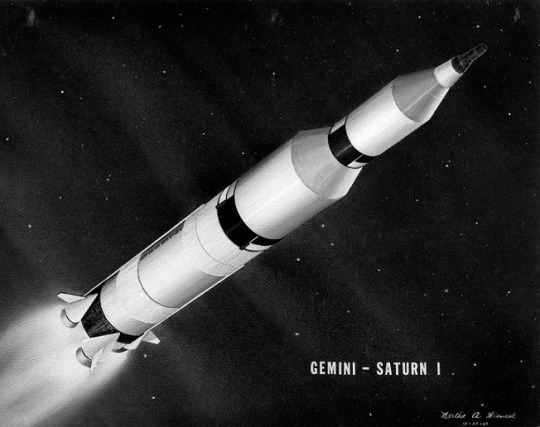
-Concept Art, however this has a typo, as this is clearly the Saturn V.
"American manned lunar orbiter. In l LP late 1964 McDonnell, in addition to a Saturn IB-boosted circumlunar Gemini, McDonnell proposed a lunar-orbit version of Gemini to comprehensively scout the Apollo landing zones prior to the first Apollo missions.
Status: Design 1964. Gross mass: 11,182 kg (24,652 lb).
The lunar orbit version required an Agena stage to provide the delta-V for lunar orbit insertion and trans earth injection. The 1.52 m-diameter Agena was enclosed in an inverted conical fairing to both transmit thrust loads to the Gemini and provide thermal protection during the coast to the moon.
Alternatively, a propulsion module based on a repackaged Apollo Service Module propulsion system, as had been proposed two years earlier for a lunar-landing version of Gemini, could be used. This raised the translunar injection mass of the spacecraft to 11,182 kg, well above the capability of a Saturn IB or Titan III-C, but only a quarter that of a Saturn V. The launch vehicle was unspecified, but could only have been a Saturn V used on an early test mission. The mission profile would have involved a 68 hour flight from low earth orbit to lunar orbit, a 24 hour lunar mapping mission in a 10 nm x 80 nm lunar orbit, and a 68 hour return flight. The scientific equipment would consist of a modest camera array installed in the nose of the spacecraft. This consisted of a long focal-length telescope, to which were attached two narrow-field stereo mapping cameras, a wide field mapping camera, a panoramic camera, and two 16 mm film cameras. The film was not accessible by the astronauts, being stored in a film vault shielded against radiation in the nose of the spacecraft. The camera compartment would protrude from the stub nose of the Gemini after parachute deployment.
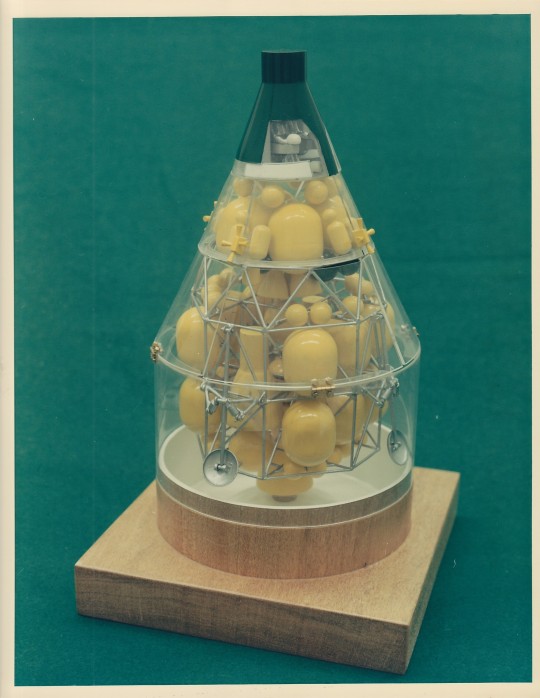
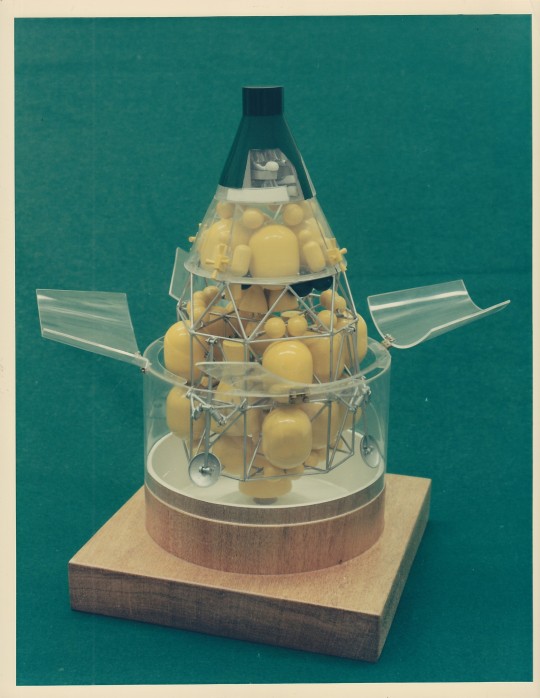
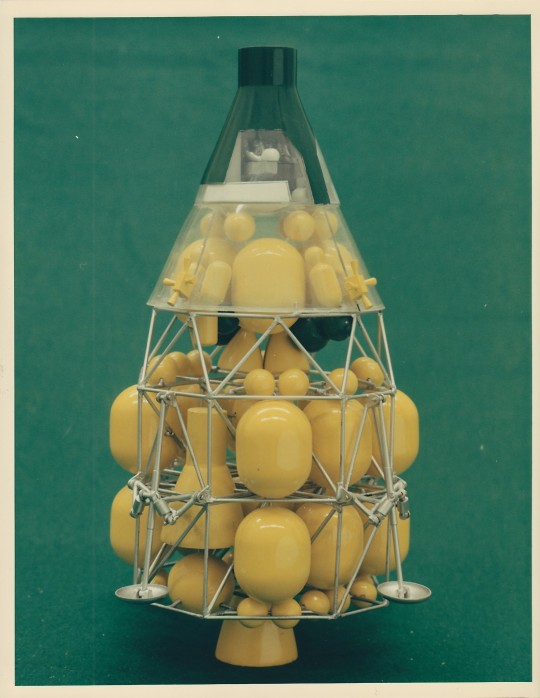
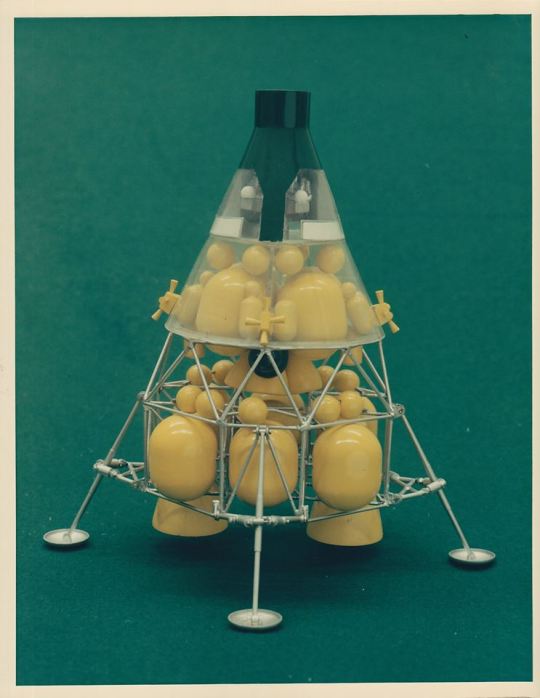
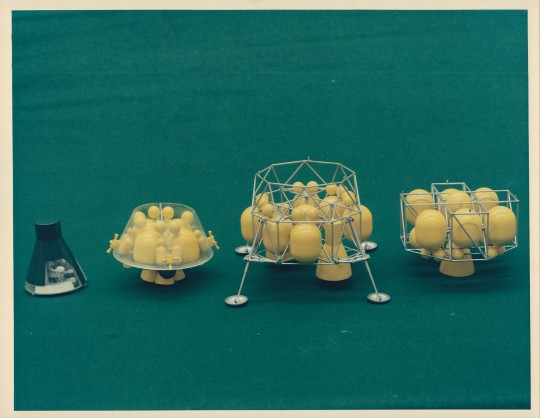
The manned portion was the same as the circumlunar version, a modified earth-orbit Gemini. The aft modules would be retained, but with the retrorockets removed. The retro module space would be used to install Apollo-type lunar distance communications, navigation, and test equipment. Deployable DSIF omni-directional and parabolic antennae would deploy from the aft modules to support lunar-distance communications. To handle re-entry from lunar distances, several modifications were necessary. The capsule's heat shield would be beefed up, and the Rene 41 corrugated shingles of Gemini's skin would be replaced with ablative shingles. The load of attitude control propellant for the capsule's reaction control system was substantially increased. Additional strap-down gyros and solar sensor packages would be added to provide navigation system redundancy. The ejection seats would be deleted and a Mercury-style launch escape tower added. The then-planned Rogallo wing recovery system would be used to glide to the Gemini to a runway landing on US territory after return from the moon. To handle the scientific payload, a camera compartment was added to the nose below the parachute/Rogallo wing housing. The Gemini spacecraft modified in this way had on on-orbit mass of 3955 kg as compared to the 3207 kg of the earth-orbit version.
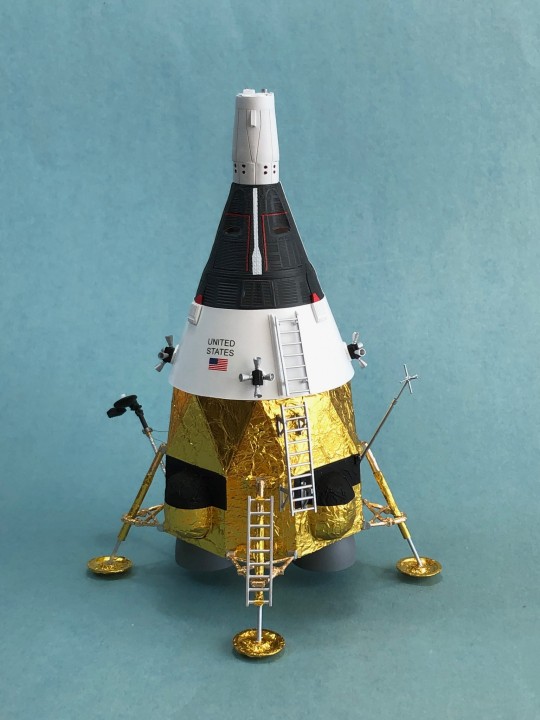
Crew Size: 2. Habitable Volume: 2.55 m3."
-information from Astronautix.com: link
source, source, source
#Gemini Saturn V#Gemini#Gemini Capsule#NASA#Gemini Program#Project Gemini#Saturn V#Rocket#concept art#artwork#cancelled#Lunar Gemini#1964#preliminary design#Cancelled Mission#my post
65 notes
·
View notes
Text
Runner, Pt. 2
They gate to the planet with the high UV radiation index in a puddle jumper, and where Sheppard is obviously steering, McKay has taken the second seat. Previously, McKay usually sat behind Sheppard and Ford had the second seat, probably because it's the gunner's position and Ford was the most useful person to sit there and look at targets for him. Regardless, McKay has changed seats and taken what would be his rightful place by his side. Riding shotgun is the privilege of a significant other, and while they may not be together-together anymore, they are still significant to each other.

However, we don't know how McKay wound up sitting there--whether he claimed the seat, ended up there by chance, or whether Sheppard had wanted him to take the seat. Given that Lorne, his new second in command is on board, a case could be made for him to have taken the seat. But then, McKay and Teyla are on his own team, so the privilege should probably have gone to one of them. And a case could also be made for Teyla, as a lady, to have been given the privileged seat. But alas, it is McKay that we find next to Sheppard. And this is their usual seating arrangement from hereon out.
They land the jumper, and we find Sheppard and McKay bickering with that old married couple energy:

Sheppard: Life signs detector's useless. McKay: I told you so. Sheppard: Just preserving your streak of being right? Officially.
McKay's "told you so" is given with such gusto that it's pretty telling. It also informs us that we are once more missing a part of this scene because we did not, in fact, hear McKay "tell him so." But Sheppard's response to him here is strange. What does he mean, officially? Why does he say it with a playful smirk and raising his eyebrows in a way that indicates there's some backstory to this? When we look at the previous episode, McKay wasn't right the whole time and in fact Sheppard got more things right than McKay did. His streak of being right, whether official or unofficial, cannot be a reference to the events of the previous episode. And the way McKay says "told you so" makes it seem as though it's not the first time he's said it in recent times.

It's possible McKay has been pointing out more errors for Sheppard and in Sheppard's behaviour than he had done previously. It's not that he was previously giving Sheppard "best behaviour Rodney" but when someone is in love, they tend to see the other person through rose-coloured glasses, being blind to their flaws. When you're in love, letting their flaws slide is natural. But it seems as though by this time, they are both severely chafing on each other, intentionally or unintentionally getting under the other's skin, and so they are both bringing out the worst in each other in a vicious circle. McKay is behaving like a haughty know-it-all and Sheppard is being a snooty asshole, going back and forth, back and forth. Truly they are a match made in heaven. And while neither of them wants to be like this, they seem helpless to break the cycle.
But, even though it might not seem like it, they are both trying to make this work. They are putting in the effort to stay professional:


McKay: Doctor Parrish believes that the indigenous plant life retains enough residual radioactivity absorbed during the daylight to, well, to screw up our sensors. Sheppard: Making it the perfect place to hide. McKay: Yes, or the perfect place to be exposed to dangerously high levels of solar radiation!
McKay is being Sheppard's science officer. He is giving him factual information to make his decisions by. And he's not wrong, either. Especially for the two of them with their recent radiation exposure, this planet presents a clear risk. And while it's not even that Sheppard doesn't believe McKay, it's that he's being entirely too stubborn to actually hear what the other man is saying, and this stubbornness has very little to do with Ford. But Sheppard, too, is trying to remain professional, giving them orders based on his strategic evaluation of the situation.

He also gives a manly grunt as he adjusts his... weapon, which just may confirm Lorne's belief that Sheppard motivation for treating McKay the way he does here has to do with masculine performance, or McKay's lack of the same.
Sheppard: Start a sweep, teams of two. Radio contact every twenty minutes... How come it smells like I'm on vacation? McKay: Mmm, could it be the simulated tropical aroma of cocoa butter? Sheppard: Strong enough for anyone within five miles to smell you. McKay: Like they haven't been tipped off by the Aqua Velva? Sheppard: It's dark.
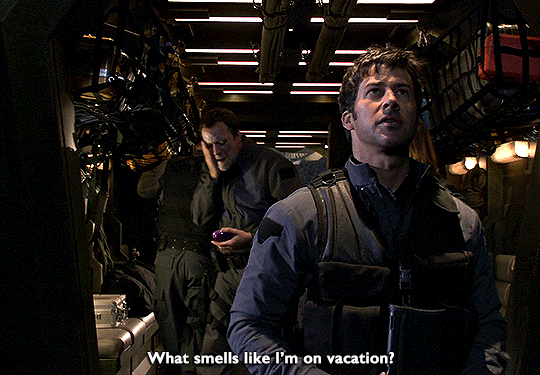
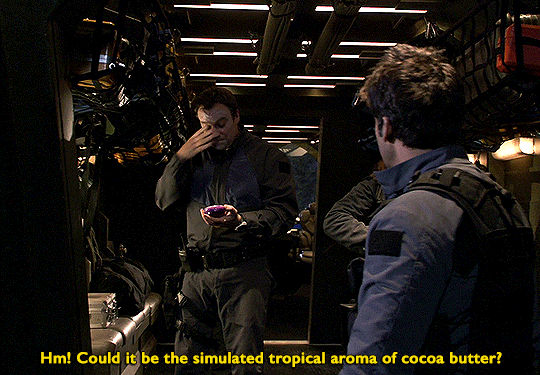
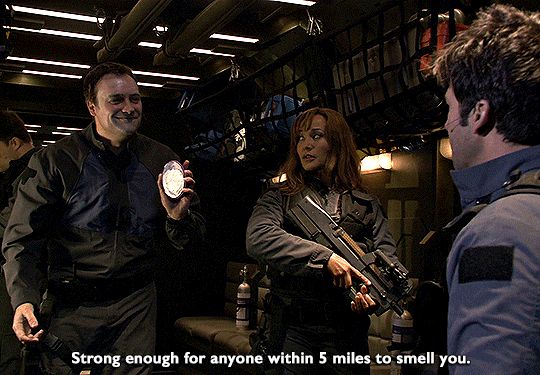
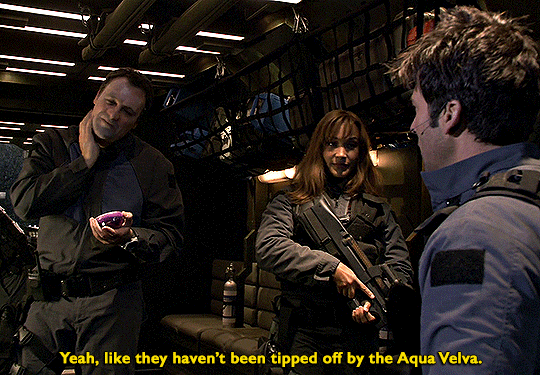
This exchange is fascinating.
For one, Sheppard loves the beach. We later learn that he likes surfing (in fact, he tells McKay in The Last Man (S04E20) that "surfing a thirty foot wave in Waimei is cool!", implying it's the best thing he knows). Also, when he has an actual vacation in Brain Storm (S05E15), he describes the destination as "a beach that's never been surfed or even touched" and in Travelers (S04E5), he's returning from "a tropical paradise" from a supply mission he had volunteered for. So, he loves the beach and ergo something that smells of vacation to him must be a really good smell. It's a smell that takes him right to his happy place (and also, while we're on his happy place, he turns to face McKay just as soon as he's out of the jumper; even now his body just cannot seem to bear to have his back turned to McKay). Interesting in this regard is the meaning of the name Rodney, often derived from "Rhoda's island" which is meant to evoke "images of breathtaking beaches, gold sand, and crystal clear water". And if this wasn't obvious enough, they later emphasize it by giving him the name Meredith, ruler or protector of the sea. John Sheppard loves the sea, is the thing. He loves the beach. And apparently when Sheppard is on vacation, cocoa butter is involved.
Now, did McKay know that it's one of Sheppard's favourite smells when he concocted the sunscreen? This, we can't tell. However, McKay himself seems to know what Sheppard smells like. Real up close and personal. He knows the aftershave Sheppard uses. He knows Sheppard's personal grooming habits. There is no earthly reason for a guy to know, and even less to have made a mental note of, another man's aftershave if they're just co-workers. And here, he's making a dig at Sheppard using this very personal information.
Interestingly, Aqua Velva is also a cocktail that one might have on a beach vacation, and McKay might be implying that he can tell Sheppard has been hitting the gin a little too much recently, which would admittedly put a pretty dark spin on this. Probably he didn't mean to imply this, as McKay is pretty straightforward with what he says, there's barely ever hidden meaning to his words. That's not how he operates, he's an open book. That, of course, doesn't mean Sheppard could have taken it that way, as he has a penchant for double entendre, especially in the case he actually had been drinking (and it's entirely within possibility that he has; the nights suddenly seem longer when you're not watching someone sleep like you used to).
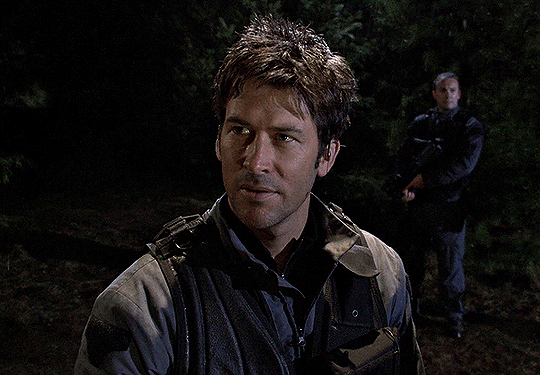
Sheppard's response to McKay's dig is "It's dark," and the assumption is that this is an argument against wearing sunscreen. It's dark, hence the sun isn't up, hence there is no need for sunscreen. Only, he says "It's dark" as a response to McKay's line about the Aqua Velva. He makes it sound like his argument is that the enemies won't be able to smell his aftershave because it's dark, like that makes any sense. What Sheppard actually seems to have done is to ignore McKay's comment entirely, just skipping right over it, either because he didn't deem it worth answering or because he simply didn't have an answer to it. If he has been sleeping in his fatigues (and it seems as though he has), it's likely he has been skimping on other forms of grooming also, and splashing on some aftershave might have been an attempt at covering up the fact that he hadn't showered that morning. The fact that he was still wearing his fatigues from the previous day also suggests that this was the case; if one showered, they wouldn't put back on the rumpled clothes they slept in on. So, because McKay was still preserving his streak of being right, unofficially this time, he chose to ignore his comment instead.
But this whole exchange is again the two of them having a conversation inside a bubble of their own where the others are not invited. And given that most of the men are new recruits that don't really know either of them, it must be confusing for them to witness this interaction between their commander and his science officer. Sheppard is not behaving like a team leader and McKay is not behaving like someone who takes orders from this man. And the thing is, they don't need to be having this argument. They know where each other stands perfectly well without this exchange, and at the end of the day, they both want the same thing. They want to bring Ford back to Atlantis and fix him without getting skin cancer or losing the ability to procreate children, so they're not really at loggerheads. They don't have a disagreement.
What they have, at the present moment, is an inability to connect with the other man outside of this unending bickering, because even this is better than not having any connection to the other at all. So, they both say a lot of unnecessary things:
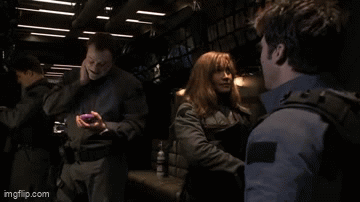

McKay: Yeah, and the sun will be up in two hours, forty three minutes and... ten seconds. Sheppard: It's raining! McKay: So we'll be cold and miserable. Look, the cloud cover will depreciate a small percentage of UV rays, but ninety-five percent of deadly is still deadly.
Again, the audience is made to think that McKay is being unreasonably cowardly when it probably hasn't been more than a week since they both got a nearly lethal dose of ionizing radiation. But we can't really point to either of them as the instigator of the this bickering, of making these digs at each other. They are both behaving this way, they are clearly acting and re-acting. Other people also seem to get caught in the cross-fire (and it's interesting with regards to the next episode that McKay seems to hold nothing but contempt toward the science of Botany). As soon as McKay turns his attention on Lorne, Sheppard tries to be the grown-up and actually splits himself and McKay up:
Sheppard: Teyla, you're with me; Coughlin, take Billick; Reed: you and Sherman cover the Gate; and Major, you've got McKay. Lorne: Oh, lucky me...
Now, Lorne clearly thinks that he got put on baby-sitting duty because McKay is the weakest link, he's the science officer with no field experience that needs looking after and as the second highest official, second most capable person militarily, he's the best person to look after him. And this is partially true. McKay is not a soldier, he has no combat experience. His field experience is limited. He does need someone to watch over him, to keep him safe. And it's logical for Lorne to come to this conclusion, as the tone Sheppard uses, he makes it sound like he's tired of McKay's bellyaching and hence wants someone else to take him on. Actually, Sheppard's internal conflict comes through in how he first says "And Major" with the tone of listen well, this is the most important thing in the world, but then the "You've got McKay" comes out in a tone that's more neener, neener, as he quickly takes off so as to avoid any backlash from McKay for his decision. Clearly, while he needs Lorne to look after McKay, he doesn't want either of them to know just how vulnerable this makes him.

Now, Sheppard could have either taken this task on himself or put anyone else on it. But Sheppard knows that since he himself is going after Ford, it would pose the most danger for McKay to be with him right now. He chose Lorne because he does think that he's the most capable fighter after himself. He chose Lorne to be McKay's personal bodyguard because he trusts him enough to be able to perform this task. He had chosen Lorne for his second in command, and he believed that Lorne would be able to take on Ford if it came down to that. Sheppard paired McKay with Lorne because he still cares about McKay, and he is damned if he's going t let anything happen to him. What ever Lorne might think, he didn't pair Lorne up with McKay but McKay with Lorne, and there's a world of difference in that.
Bitchy though he might (currently) be, McKay is the most important person in Sheppard's life, and he's not going to let anything happen to him. He's not taking any chances with his life. And the thing is--he chose not to take McKay with himself for that exact reason. He doesn't think that he's the best person to look over McKay and keep him safe, especially not now. He is distracted by McKay at the best of times but currently, the way they are bickering, if they had paired up together anyone would have heard them coming a mile away. There is no way they could have kept quiet. Even though neither of them wanted to talk about the important stuff, the stuff they should have talked about, neither of them could shut up around each other either. They both need each other's attention, and they'll clearly take it any way they can.
And given that Sheppard can't keep himself from making snide digs at McKay or from responding to the other man's subtle barbs, there is not a way in hell they can form a team of two on this mission. He needs to be able to concentrate, especially because a slip in his concentration might lead to McKay getting hurt. So, he chose the second best thing for McKay, his second in command. He trusts Lorne to keep him safe. But Lorne doesn't get this, doesn't get how much Sheppard is trusting him with, doesn't understand the importance of what he has been trusted with. He thinks he got shafted, for some reason. He got the short straw, the short end of the stick. Like maybe his commanding officer doesn't quite trust him yet, like Sheppard might be testing him or something. Lorne doesn't know what Sheppard and McKay are to each other and the way they're behaving, there's really no way for him to even begin to guess.
McKay himself, he seems fine with this. But we've got to remember that for McKay, not being wanted is his core issue. It was the fact that Sheppard seemed to choose death rather than him that had hurt him the most. While Sheppard does get in 'the last word' here with this, because he doesn't understand how McKay thinks about this, he also doesn't get how far below the belt this last jab is for him. Yes, they're trading barbs, but it's not their intention to really hurt the other. And yet, that's what Sheppard manages to do here, and he doesn't even realize it because his thinking is so very different from McKay's in this.
For him, McKay is the single most important person in his life. There is no one else in two galaxies that matters more to him, and that's a fact. Put next to anyone from either galaxy, he would choose McKay ten times out of ten any time of day. And because this is so obvious to him, he can't even begin to understand why what he did hurt McKay so much. As far as he's concerned, he's doing what he thinks is best for McKay, he wants to keep him alive and safe. That's what you do for someone you love. Even when that means protecting them from yourself, which is what he does here, pairing McKay up with Lorne. But for McKay, it's high school athletics class all over again. He's chosen last because no one wants him. He's pawned off to someone who makes it clear they don't want to be paired up with him. For him, what Sheppard does is cruel.
But at the same time, this is familiar to him. McKay knows how to deal with Majors. He can break in another one. He at least tries to make friends with Lorne:
McKay: Here, try some. SPF 100. Lorne: A hundred? McKay: Yeah, can't buy this kind of protection. Make it myself. Waterproof too.
This is pretty interesting, too. First of all, McKay makes it himself. Fair enough. But Sheppard knew that he does this. Earlier, back in Weir's office, Sheppard said "Bring your sunscreen". Not "bring sunscreen," not "bring the sunscreen," not "put on some sunscreen," not any number of things he could have said if he was referring to general sunscreen, or just making a snide comment. He told McKay to bring his sunscreen, knowing that McKay has made his own sunscreen. Knowing that McKay had sunscreen that he had made for himself. Sheppard knew about McKay's sunscreen. Which is interesting in and of itself.

But then he tells Lorne that it's waterproof. Sunscreens generally aren't water resistant, although obviously there are waterproof ones out there and, if one had aspirations of swimming while wearing it, it would make sense to make it waterproof. So, it's possible he had made it with swimming in mind, whether for himself or for someone else that might canonically enjoy the ocean. OK. But what on Earth made him try his hand at mixing up body lotions in the first place? What, he's suddenly Alfred Garnier of Atlantis? From what we can tell, this man barely knows how to cook and probably survived mostly on instant noodles outside of institutional cafeterias his whole life.
The thing is, they probably didn't have a whole hell of a lot in the way of lubrication the first time they came from Earth. We don't know what the expedition's policy was on sex and sexual hygiene, whether bringing condoms and other assorted paraphernalia was a priority, but how ever much of this stuff they did bring with them, at some point during the year, it would have run out, just like the coffee. If there was any lube intended for sexual purposes to begin with, it would eventually have run out. And after that, just like the beans they attempted to substitute coffee with, it would have been up to them to come up with alternatives. And here, McKay is suddenly an expert in mixing up waterproof lotions. And let's not glide over the fact that he's using this to bond with Major Lorne, very possibly a closeted gay man in the military. He's letting Lorne know that if he's ever in the need of waterproof lotion, he's the man to see about that on Atlantis.
Granted, this sunscreen that smells of cocoa butter is not something Sheppard has smelled before--at least outside of the context of a vacation. Sheppard is not familiar with this lotion. But this does seem to be a new mixture, the fact that it has the simulated aroma of cocoa butter is a new thing. But it is interesting that McKay specifies that the sunscreen is waterproof here when sunscreens most often are not, whereas personal lubricants used for sexual purposes which are particularly useful in all manner of sex acts between two men due to a distinct lack of natural lubrication, well. What we know now is that McKay had, at some point in his life, learned how to make waterproof lotions that made the skin slippery with its base of vegetable butter. And we, as the audience, apparently really really needed to know this. Safe sex is important, after all. And I'm not saying he had made this particular lotion as lube, although it probably would work as such. I'm saying, he clearly has acquired the know-how to make sunscreen and other lotions through personal necessity.
And now we know this about him. Now we know this about them. They might not currently have any use for it beyond staving off radiation but they have used it in the past and they will use it in the future. And Sheppard won't mind if McKay's new stuff smells like a beach vacation. He won't mind at all.
Continued in Pt. 3
#sga#stargate atlantis#john sheppard#sga meta#sheppard is bi#rodney mckay#rodney is gay#ep. runner#ep. the last man#ep. travelers#ep. brain storm
23 notes
·
View notes
Text
Lithiola
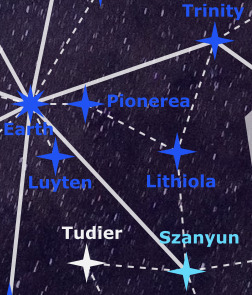
The HD 85512, now named Furnar, star system was one of the earliest to be colonized. In it, the "gold and silver planets" of Pekelmaan and Lithiola were found fit for settlement. While moderate in habitability and resources by modern standards, with both having predominantly dry climates and thin atmospheres, they were both heavily developed by their host nations in the European Federation and the African Union. However, early sensors failed to detect that Pekelmaan's magnetosphere was weakening drastically due to a geomagnetic reversal until colonization was well underway. The pace of deterioration due to intense solar radiation proved too fast to counteract. As such, most Pekelmaanis were evacuated to Lithiola.
Though the two planetary colonial administrations were merged, the Furnar system was given less attention by Earth in favor of more promising colonies like Szanyun, Trinity, and beyond. While it wasn't unaffected by the Great Blackout, it suffered less and for a shorter amount of time due to being more developed and nearer to Earth. In the following decades, the colony underwent a period of deindustrialization and economic stagnancy, and there was a feeling of ostracization from the rest of its fellow core worlds.

Nevertheless, Lithiola bitterly resisted the IWC forces during the Secessionist War, blocking entry to Earth. The Furnar Campaign lasted for a few years, destroying much of the system's infrastructure. After the War and with the collapse of the Colonial Directorate, the Furnar star system would be given nominal independence as the Union of Lithiola. It transitioned to a federal parliamentary republican state, with 694 autonomous provinces and federal territories grouped into 21 provincial regions.
Internationally, the Lithiolan nation has joined and is deeply integrated into the wider Stellar Confederate Union. The economic aid and benefits from being a member have helped it to rebuild and diversify. Earth remains its largest import and export partner. Furthermore, Lithiola does not operate a standing military, instead relying on the SCU's mutual defense. As such, Lithiola is still very much tied to Earth's United Nations economically, politically, and militarily.

#worldbuilding#cold dawn verse#scifi#sci fi#science fiction#this is an aspect of the SCU that has Earth as implicitly neocolonialist as opposed to just imperialist#The economic weight of Earth is so strong that it just makes sense for a lot of SCU member states to continue with nominal independence#Lithiola is legally independent but is nevertheless subject to the SCU that is very much controlled by Earth#This is part of the theme of Cold Dawn#of conflicts between individual nations and the greater benefits and costs of being a part of a bigger union
4 notes
·
View notes
Text

A Curtain of Dust Over the Tarim Basin
Spring is peak dust storm season in China’s Tarim Basin, particularly in the southern part of the dry, barren depression. It’s a time of year when regional wind patterns shift in ways that cause winds and storm systems to sweep in from the northwest. In early spring, when landscapes in this region are especially dry and have minimal vegetation, land surfaces warm rapidly under the Sun’s heat every morning, fueling convection that can help loft dust upward by the afternoon.
The image above shows dust sweeping across large swaths of the basin on March 27, 2025. The image was acquired at 12:23 p.m. local time (04:23 Universal Time) by the MODIS (Moderate Resolution Imaging Spectroradiometer) on NASA’s Terra satellite. A more detailed view (below), captured on the same day about an hour later by the OLI (Operational Land Imager) on Landsat 8, shows a gap in a dust layer in the southern part of the basin. Visible through it is part of the Tekilik Shan, a subrange of the Kunlun Mountains with several snow-covered peaks that reach elevations of more than 4,000 meters (13,000 feet).

The shapes of the fingerlike dust protrusions appear to reflect the underlying terrain. The protrusions line up with underlying valleys, which help control the flow of airborne dust. Dust may have been “self-lofting” over the course of the day. This can occur as the Sun heats recently mobilized near-surface dust, fueling pockets of convection that help lift dust particles higher into the atmosphere, explained Ralph Kahn, an atmospheric scientist at the Laboratory for Atmospheric and Space Physics at the University of Colorado Boulder and scientist emeritus at NASA’s Goddard Space Flight Center.
Supporting this interpretation, geostationary observations from Japan’s Himawari-9 satellite show dust creeping upward into the Tekilik Shan in hourly increments throughout the day before eventually obscuring the view of the mountains in the late afternoon. A similar process occurred on other days during the late-March outbreak of dust, including March 28 and 29.
Since the early 2000s, researchers have observed a 1.5 percent decrease in the amount of atmospheric dust detected by MODIS sensors in this region each year. “The trend was likely linked to shifts in the spring—March, April, and May,” not in other seasons, said Hongbin Yu, a research scientist at NASA Goddard. The change is likely related to changes in wind speed or shear, vegetation cover, or soil moisture, he added.
The Takla Makan Desert is one of the driest, most barren expanses on Earth. Flanked by mountain ranges on three sides and parched by the resulting rain shadow, parts of the Tarim Basin receive no more than 10 millimeters (0.4 inches) of rain per year.
Dust storms can lead to public health problems in populated areas downwind by transporting small particles, bacteria, and viruses that infiltrate human respiratory systems. Dust storms can also affect Earth’s climate by scattering and absorbing incoming solar radiation and changing the properties of clouds.
NASA Earth Observatory images by Michala Garrison, using MODIS data from NASA EOSDIS LANCE and GIBS/Worldview and Landsat data from the U.S. Geological Survey. Story by Adam Voiland.
2 notes
·
View notes
Text
Get the SOZ-03 Solar Radiation Sensor Pyranometer in India for comprehensive Solar Monitoring Systems at the best price. Enhance your Solar Monitoring Systems. Contact us now.

0 notes
Text
995F:Is this bloody channel working?
B95:Read you loud and clear SS stabith 995F
995F:Thank blood [figure of dignity]
B95:SS stabith, are you alright? Sensors indicate that we are unable to communicate with you via anything other than short wave radio.
995F:Yea yea station B95. We flew close to a star and the bloody ball of hot gas unleashed the mother of all storms at us.
B95:Wait...a solar Flare. But records shows that vessel has no radiation shielding. How are you all alive and how did you all make it to us?
995F:With a lot of duck tape....and some human ingenuity.
B95:....
995F:Can we dock? This radio we managed to rig together with our life support system is starting to smoke....
16 notes
·
View notes
Text

Autobot Jazz Week day three! Prompt: Candy/Sweets. Jazz wants to play the Pocky game, naturally using Energon treats. Song is “I Want Candy” by Bow Wow Wow.
Ficlit: Candy Conflict
“If you wanted a kiss, you could’ve just asked.” Prowl strained backwards, not wanting to break their embrace but also trying to avoid the Energon treat, flipping up and down rapidly in a playful manner from its place clenched between his Conjunx dente plates.
Jazz scowled in irritation and removed the candy from his lips so he could speak clearly. “The kiss isn’t the point. I want to try the game. You know, try something different.”
The taciturn Security Officer squirmed. Why did Earthlings have to come up with such silly ideas to waste time? And why was his mate so fascinated by the little ones odd habits? “Couldn’t we just make out, then eat the candy like normal people?”
Jazz growled in frustration and threw up his servos in a rare sign of hostility. “Well excuse me for wanting to indulge in the local cultures. I mean we’re stuck here on Earth, might as well enjoy it. But fine, if my hobbies offend you so greatly, I’ll take my candy and find someone who does want to play!”
His beloved was half way to their quarters door when Prowl registered what he had just said. “Wait a minute! Jazz, hold on, you’re going to just go off and…” he ironically decided on a human term “snog some other bot?!”
The Master Spy coldly glared at him from over his shoulder and snapped “First off, like I said, the kiss ain’t the point! And even if it was, why not? You weren’t the first Mech I ever kissed, and it doesn’t have to be sexy, it can be an innocent kind of thing. I’m your Conjunx but that doesn’t mean you own me Prowl of Praxus!”
“No, no, of course not!” Prowl waved his servos and shook his head, “I’d never presume such a thing Love. It’s just…”
Seeing his one and only look so hurt made Jazz exvent and pinch where his visor rested on his olfactory sensor. He slowly turned with his servos spread wide in a slightly pleading gesture. “Look Prowl, I love ya darlin’ but there are solar cycles where I could just deck ya.” He chuckled in a sad way. “We’ve been Conjunx a long time and hardly get to see each other we’re so busy with our duties, and we never know if we’re gonna see each other ever again whenever we go on missions… I just wanted to play a little game I thought was cute, is this really worth arguing over?” He dropped the box of Energon treats into a small trash receptacle and looked so rejected it physically hurt the other Autobot to witness.
Prowl got up from his place sitting on their recharge berth and quickly transversed the distance between them. He embraced his Conjunx Endura tightly and peppered his helm with kisses. “I’m sorry Jazz. You’re right, you never ask for anything and this was such a simple request. I’m sorry I made such a big deal out of this.”
Before Jazz could respond, Prowl left the warmth of their embrace and retrieved the box of candy. He took his love by the servo and guided him back to their starting point sitting on the berth.
Jazz was grinning like a Sparkling with a new toy as he dug out a fresh treat with every intention of reinitiating the game, when he was interrupted yet again by an oddly suddenly shy Prowl.
“Heh… hey love?” The CSO mumbled, avoiding optic contact and his face plates were dusted a pretty blue blush.
“Yeah handsome, what is it?” Jazz was very intrigued now. What could possibly have his normally stoic mate acting like an unchristianed youngling about to have his first tumble?
“Who… uh, who would you have gone to if I hadn’t stopped you from leaving?” Prowl murmured. His EM field was radiating arousal despite his bashful nature.
‘You adorable, sweet, secretly kinky mech.’ Jazz thought to himself as he slowly grinned like he normally only did when getting the upper hand in battle. “You really want to know darlin’?” He drawled and felt his engine hum happily at the shy nod he received in answer.
“Then you better win the Pocky game. That can be your trophy.”
13 notes
·
View notes
Text
White Knight
Sol’s Stalwart Defender
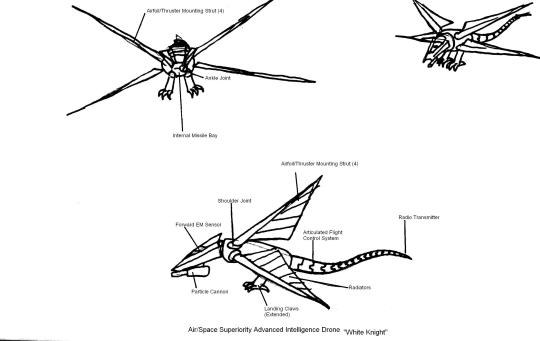
Length: 15 meters
Wingspan (fully outstretched): 10 meters
Empty Mass: 5700 kg
Armaments: 6 Mark-IX radiation-seeking fusion missiles, 1 particle cannon (12.1 GigaWatt range)
Maximum Delta-V: <redacted>
Minimum Turning Radius: <redacted>
There was only one thing more frustrating than the rejection of the Intelligence Air/Space Superiority Drone Prototype “White Knight” from front line service and its assignment to interceptor duty in the Outer Solar System. That would be the fact that they left me on. Five years the war had gone on now, and all I had to occupy myself was staring at thousands of dead moons around the four gas giants. A post-human mind can only take so much. Locked into my launch tube on Uranus’ moon Titania, I could not even move. I might not have minded so much, but a layer of dust was starting to form, and the maintenance drones refused dust me, insisting that it was not a maintenance problem, as being dirty did not interfere with my primary functions. They may not be legally sapient, but I swear those things have developed a capacity for a malicious sense of humor.
Then one day, something unexpected happened. My EM sensors picked up a pattern of radiation, the sort only produced by the formation of an opening into hyperspace. Something was coming out near Saturn. It was fairly faint, probably an attempt at stealth, I would be the only one in the solar system that could see it, who knew that a potentially enemy craft was entering our space, whether to spy or hit and run. I sent a signal to Command, but it would be at least forty-five minutes before the signal would get there, five hours before any craft from Earth could get out this far. I was on my own. A cloud of regolith erupted from Titania’s surface as I blasted off toward Saturn at full burn.
Coasting into the Saturn system. I brake just above the rings and run silent, trying to minimize any internal radiations that could distract me from the intruder’s telltale energy glow. To win this, I would need the element of surprise more than anything. Then something moves below, a great fish amongst the school of glaciers. It rises up out of Saturn’s rings like a breaching whale: the spherical hull of an enemy escort carrier. This I had not foreseen. I was expecting a covert ops craft, maybe a small frigate or destroyer. That the enemy could smuggle in something like this so unobtrusively has dire implications. But that’s not relevant now; now I need to worry about the fact that the detection equipment on this sort of ship could pick me apart from the debris in this system even if all my systems were completely online. A feeling suspiciously like a fight or flight instinct kicks in as I fire my thrusters to dive into the ring, arcs of burning plasma close enough that I can feel their warmth on my metal skin. I wonder if that was something my programmers built in, something like a simulated adrenal gland, of if it is all in my mind, something inherited from the human pilots whose minds were scanned, replicated, and merged to create mine.
In this ring I have to move at what feels like a painfully slow pace. This isn’t like the Asteroid Belt where you could fly all the way through without even seeing a single object; here the blocks of ice are as close together as I am long from nose to tail. I have to concentrate every second on weaving between them as they spin and bob and collide with one another. This isn’t helped by the fact the escort carrier has launched a flight of fighters after me, writhing octopoid drones with thrusters on their manifold tentacles. I swerve in a flat spin and boost inches away from a large chunk; the missile chasing me can’t turn as tightly by a fraction of a degree and impacts, the glow of a nuclear fusion explosion blinds my rear sensors for a moment. Unfortunately for a pursuer, its forward sensors were the ones blinded, it smacks head on into the shattered pieces of the late chunk of ring, adding its own fuel to the conflagration.
I notice one fighter hanging below ring level. I drop out for a moment and launch two missiles. The enemy’s point defence plasma cannon is fast enough to stop one missile, but by the time it shoots at the second it’s already inside the blast radius and melted in an instant.
Flying back into the ring, I extend my landing claws and perch below an outcropping on one irregularly shaped bit of ice. I fill the spectrum with static, drawing the enemy in but making them unable to find my exact position. When two fly past I open my missile bay and launch my last four warheads at them. Three all lock on to the same target, vaporizing the enemy before it can react. The other sees the missile coming and ducks behind two colliding rocks, which absorb the blast’s energy. This one’s a mite cleverer, his red stripes probably indicating a higher-end model. He immediately traces the missile exhaust back to me, and matches my every move when I blast off again. He saves his ammunition, opting to close to point-blank range so I can’t escape.
I burn through fuel trying to outfly this one, exhausting the spaceborne equivalents of zigs and zags, immelmann turns and aileron rolls, but somehow he’s always right on my tail. I break out of the rings and make for the moon Titan. After a few thousand kilometers of just barely outrunning my opponent, I hit the moon’s atmosphere at a deep angle, hoping the rapid deceleration will make him overshoot. The drag feels like it’ll pull my wings off, I shake and knock about, a trail of fire behind me that could reach across a small country. Then the missile comes. It’s a near miss, detonated by the atmospheric shock waves, but it knocks me out of control. The aerodynamic shear rips off the doors to my missile bay and one landing claw. Something’s come loose inside. I can hear it rattling around when I move. I visualize gritting my teeth as I sever some pain receptors so I can concentrate.
I rise out of the atmosphere to find him behind me still. He fires three missiles, but is still a few clicks away so I have time to shoot them down with my particle turret. His arsenal must be exhausted, he begins closing the distance between us so I can’t dodge his plasma cannon fire. Perfect. When he gets within a shiplength I cut propulsion and fire all the thrusters on one side. As I spin on the spot to face him I fire my main forward particle cannon, the coruscating indigo beam cuts him neatly in half. I hang about for a moment to watch the little bits of him spiral down and burn in Titan’s smog.
Through all of this the escort carrier has been steadfastly trundling along on its original course for the Inner Planets. It now hung in front of Mimas, a tiny 150 meter-in-diameter replica of that moon in shape and color. There were those who said all spacecraft should be such, that my own streamlined and mirror-polished form was inefficient and backward. That was probably not the most positive thought to be dwelling on at the time but it took quite a while in computer time to get back to where the starship was now and that was where my mind went. I am the sum of all human dogfighting skill, a gestalt of the minds of the best pilots Earth ever produced. It was only natural they should give me the body of an aerospace fighter, a compromise of what a spacecraft needs and what an airplane does. Lot of good that did me; first time in years I go into an atmosphere and I almost flay myself. Though I wasn’t doing half bad outrunning those enemy ships even with these airfoils weighing me down.
I must be in the carrier’s range now. Bolts of plasma are streaking past my nose. A pure AI would probably already be vaped now, tracked by the mathematical precision of the starship’s computers. I am unpredictable though; a human mind with a computer’s speed. They have no idea what I’ll do next. Well, unless they have more like that last one.
The missiles come now, slower than the near-massless ionized gas. Next will come fighters, but one problem at a time. When they come closer I fire my particle cannon, groups of converging projectiles now close enough that their explosions catch one another, creating a wall of light between me and the carrier. I use the distraction to find a small rock just larger than I am floating some distance from the ring.
I latch onto its surface and rotate my side away from the enemy. Hopefully before the enemy sensors clear, I fire thrusters, then turn everything off that would emit detectable radiation. Hopefully the rock’s mass will shield me from their active scanners. After an eternity of five minutes the greenish glow of the carrier’s defensive energy screen fills my passive sensors. I immediately jump off the rock, and notice the plasma turrets on the carrier’s surface popping up and whirling to face me like surprised meerkats. I am amazed at how close I managed to get, they must be very confident in their ability to withstand a meteoroid impact.
The guns fire. There is searing pain as gas the heat of a small sun burns holes in an airfoil, but that was the only shot they’ll get. I brake just above the surface of the enemy ship, closer than anyone could ever have expected in a space battle.�� The plasma turrets cannot traverse low enough to shoot me, instead they anemically ram their magnetic barrels into the lowest range of their tracks over and over. I suddenly become aware of my own reflection on the glossy ceramic hull below. I...have never seen myself before. Sure, there were diagrams, schematics, the diagnostic readout in my head, but that’s a fair amount different from actually seeing it. I suppose I had always just visualized myself as just a more flexible fighter jet, an F-14 Tomcat or something with cockpit and wings on a swivel. But I see the irony in my name now: the White Knight, once human, now cast into the form of a dragon to fight where no man or woman could. Then I notice that I’m standing on one leg like a flamingo and the silliness of that rather reduces the profundity.
The holes in my wing are still glowing white-hot around the edges, but the pain reception must have melted. I’m really more of a Black Knight now, my gleaming heat-reflecting coating having been mostly burned away. I realize I didn’t really plan beyond this point. I look up to see the enemy fighters swinging back from their sweep to find me. Then I realize the opportunity I’ve been given. I lean back and fire my particle cannon with impunity, as the enemy can’t fire back without collateral damage to their own starship.
A half dozen enemy fighters wither before my fiery glare, but then I notice another with red stripes. He races forward, firing missiles with wild abandon. The carrier’s turrets fire a bit delayed; some technician inside probably had to rapidly reprogram them to target “friendly” projectiles. Through the dissipating energy the enemy lands right next to me, tentacles first. He pauses for a moment to rip out its own communication antenna, some part of me imagining he’s trying to ignore the beratements of some superior inside the carrier, I blast off, and though my speed is a relatively slow 300 kph, it feels like faster than I have ever been because of the carrier’s superstructure racing by as I hug its spherical surface. I intentionally narrowly dodge antennas and turrets, but my enemy clearly has a much tighter turning radius than I.
He begins firing his plasma cannons, at this close range he cannot miss. The damaged airfoil is severed completely, reducing my maneuverability and thrust by a fourth. I slow and stop behind a large structure sticking out from the escort carrier’s hull. The second Red Stripe just keeps on going, first trying to get me by blasting through the tower and taking me with it. His cannons insufficient to penetrate its armor, he flies past and begins rotating back around. He is still shooting, but not directly at me. I’m damaged. He could finish me off at any time. This one’s intelligent enough to desire revenge, to toy with me and kill me slowly. They really need to work on that bug.
Seeing my severed wing drifting by, I quickly run a trajectory calculation. As Red Stripe gets right up close I fire its thruster, shooting the metal triangle right through his octopus head. The airfoil tears keeps going and sticks in a turret gun, then explodes. Red stripe makes a motion like a salute with one tentacle, though it could have just been a dying spasm, for he then goes limp and slowly spins away.
The I see a whoosh of gas escaping into the void and crystallizing a quarter of the way around the sphere. One fighter comes out, then another. The hangar doors are open, they’re launching reinforcements. Just what I needed. Actually, I couldn’t have planned this better. I rocket into the path of the launching fighters, shooting blindly into the hole from which they emerged. One fighter about to launch explodes, then another. The escaping atmosphere blows me away from the growing fire and internal explosions. The carrier’s engines go offline, and the festering hole in it’s side is now acting as a thruster pushing it back the way it came. I check the time: it’s been seven hours since I sent a message from Titania. I slowly spin there, watching the carrier’s crew in spacesuits desperately trying to make repairs. Maybe I should sell them some maintenance drones.
An hour later I see it. A new star growing that I zoom in to see is one of our light cruisers. It fires a warning shot two kilometers away from the stricken enemy with its railgun, a special round coated with brightly glowing chemicals and designed to self-destruct to prevent its eventually hitting somebody.
The world seems like it’s losing resolution, and I realize my sensor input is actually becoming more pixelated. Soon it becomes dimmer as well. I’m not afraid of termination. Though granted, they can probably rebuild me if I’m anything less than vaporized. It’s too bad; after all that I could have used a bit of rest. I don’t know if my transmitter is still working, but I tell it to send a message anyways, “I see why you wouldn’t send you wouldn’t send us to the front! You needed me to do all the work around here!”
#short story#older work#ive gotten better since this honest#scifi#starfighter#space battle#transhumanism
3 notes
·
View notes
Text
coupled to reverse electric motor
so here's why:
we can actually make power from photon radiations itself but neutrons are spicy assholes
neutrons break stuff, and only make heat because they have no charge potential and are massy compared to photons
like imagine how the sun can break a camera if you look directly at it with the right lens times a thousand except the sun's rays are like, subatomically power-washing the sensor so you break it
whoopsie
if you want an atom splittano that has no moving parts its gotta be neutron free or its gonna break your radiation solar panels basically
so neutrons hit stuff and they make it hot as heck
the way we know best for making stuff hot make power is to make it boil stuff and spin a guy cuz we've done it for hundreds of years and have put billions of human hours into being good at it
so we whack it on a funny jet turbine and put that on a special electric motor that instead of blowing power in, sucks it out
even the fancy high tech russian experimental reactors that used molten lead or bismuth, or the neat american "eats itself to death but it'll work honestly" very chemically questionable molten salt reactors still boil stuff
if you wanna not spin a guy to make power, you gotta not make neutrons
or you gotta know stuff about neutrons i don't
or you figured out how to do actual dilithium crystals (metastable ordered nonperiodic gamma-diodes) on the cheap
nuclear power is impressive until you get up to why. "we use the most precisely engineered machinery ever created to split atoms to release energy" oh yeah how come? "boil water to turn a fan" get the fuck out
73K notes
·
View notes